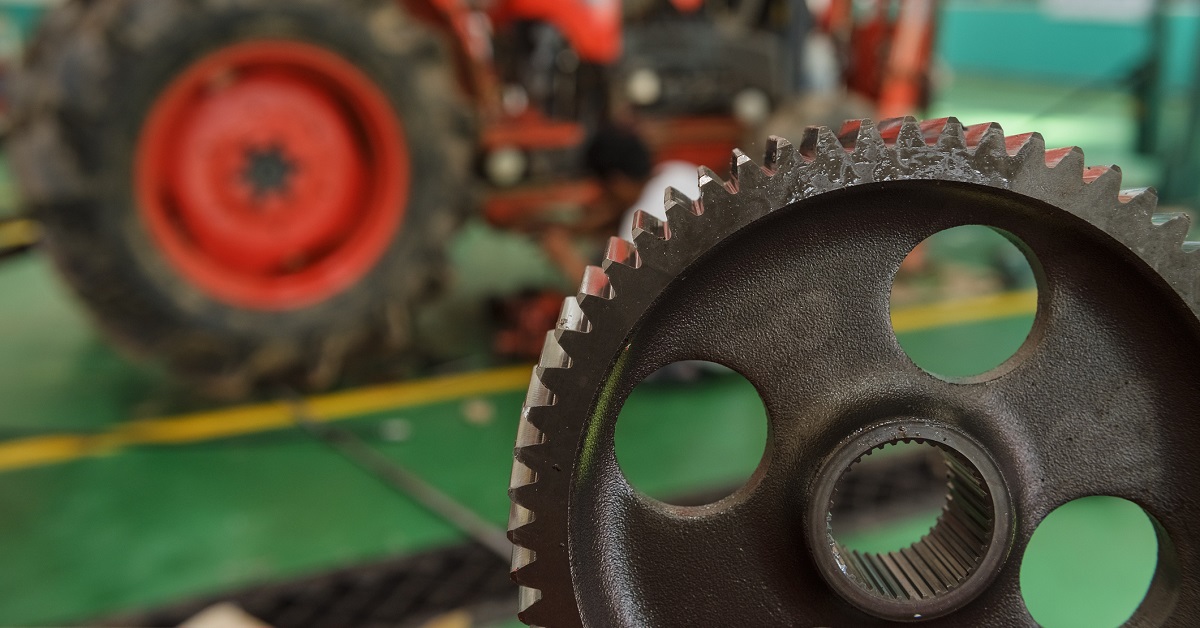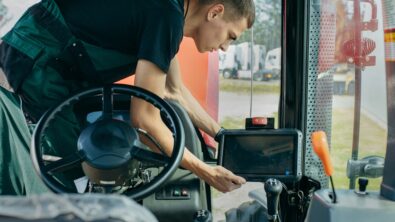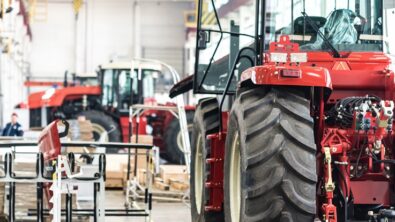3 must-haves for fast heavy equipment design

Whether you’re making tractors, combines, dozers, excavators, road pavers, mining drills, cranes, or forklifts, as an original equipment manufacturer (OEM), you must accelerate your heavy equipment design process to survive today’s disruptive times.
Equipment design combines computer-aided design (CAD), CAD-based analysis, and related activities and is essential to any new product introduction (NPI) process. It’s the part of the product development cycle where an equipment concept takes shape and where you must apply 3D modeling technologies and virtual validation to make sure your equipment design is meeting all the requirements.
Accelerating heavy equipment design is business critical
Bringing products to market in an efficient way and getting it right the first time is, of course, important regardless of which industry you’re in. Still, there are a few reasons why specifically for heavy equipment, this is extra critical.
Time pressure is inherent to the types of products you make. And top of that, some of today’s industry trends are escalating complexity in certain areas, adding even more pressure and making accelerating equipment design vital to stay in business.
In this blog, we’ll illustrate what drives the need to make heavy equipment design more efficient and how Xcelerator™ from Siemens offers you 3 must-haves that help you achieve this in a secure manner, even while complexity is increasing. Through accelerated equipment design, you will secure your margins and take the lead in a business that is in full transformation.
Here’s what you need to accelerate heavy equipment design
- A multidisciplinary equipment design approach;
- A solution to effectively manage mass customization;
- Tools that help you, while moving faster, be compliant and meet industry standards.
“In the past, it took us about one year from concept to production, and today we have cut that down to three or four months.” Anna-Gret Borchert, Calculation Engineer, AMAZONE (read more)
Accelerate equipment design. Why? And why now?
As suggested above, there is a ‘why’-side to this story, but also a ‘why now’-side. But before going there, let’s first discuss the importance of time-to-market as a business performance metric in this age of innovation.
Time-to-market as KPI for your business
For many companies across industries, time-to-market is a key performance indicator (KPI). Figure 1 illustrates why. Shortening time-to-market usually equals more revenue.

McKinsey concluded in one of their classic studies: “On average, companies lose 33% of the after-tax profit when they ship products six months late, as compared with losses of 3.5% when they overspend 50% on product development. Increasingly, advanced manufacturers are learning that the time required to develop a new product has more influence on its success than its costs.”2
Of course, time-to-market isn’t the only performance metric that matters, as McKinsey also says in another of their articles. In the long run, KPIs like customer satisfaction and consistently delivering against requirements may even be more noble and valuable goals to strive for.3
Time-to-market in the age of innovation
Still, with today’s rapid pace of innovation and continuous market disruption, you have no other choice than to try and be a frontrunner. Besides, as these innovations are increasingly software-driven, we see practices and business concepts that are common in the software industry slowly gaining ground in classic mechanical industries, including heavy equipment.
An example could be if an OEM makes the strategic choice of being first by releasing an innovative machine early, possibly for selected customers only, while everyone knows that there will be upgrades needed later.
It’s clear that if such approaches are being taken, anyone involved in equipment design will feel the pressure.
Why heavy equipment design is always under pressure
That being said, let’s focus on what is so specific about heavy equipment products, as there has always been time pressure on heavy equipment design. It’s inherent to the business, and here is why.
CTO and ETO business models
First, you have a lot of customization requests. So, you must find ways to be successful with configure-to-order (CTO) and engineer-to-order (ETO) business models. Both of those require that equipment design teams can respond quickly.
Inherently multidisciplinary machines
Second, the machines you make are always multidisciplinary. Most of your equipment has multiple functions, as opposed to cars, for example, where the predominance of the transportation function is absolute. Without a proper approach, you can’t master the associated complexity.
Time-sensitive delivery
Finally, for some of the machines you make, the delivery may be time sensitive. Think of agricultural machinery that must be available at the start of the harvest season, or of construction machinery that is critical in the context of an ongoing project. Or think about making a bid for mining equipment that needs to be ready before the tender closing date. In all those cases, equipment design is under pressure.
So, why? To secure your margins
In summary, in your business, you are always dealing with time-sensitive products that require significant engineering effort and that will come in relatively low volumes. Therefore, your margins are tight. So, accelerating equipment design is not only a way to gain more revenue. It’s something that is essential to protect your margins, remain profitable, and stay in business. It’s a way to differentiate yourself from the competition.
Why the need to accelerate equipment design is escalating now
On top of all that, there are industry trends adding more pressure. Like in all industries, there’s a massive innovation wave going on, driven by electrification and emerging digital technologies. We are still in a transition period, but during this decade, revolutionary changes will take place.
Many OEMs struggle to find the right balance between investing in R&D and focusing on delivering what their customers want/need today. Here are some reasons why now is the time to talk about accelerating equipment design.
Mass customization
Excelling at customization/personalization has become business critical now. The new generation of customers takes it for granted that you can fulfill their unique requests. And the number of requests is rising as well. Across industry segments, whether in agriculture, construction, mining, or material handling, people are exploring new and unique ways of doing things.
To do so, they want to leverage those new technologies that are reshaping the world today. Therefore, they often need you to provide them with unique equipment.
Market globalization
In increasingly globalizing markets, such requests come from all around the world, where a variety of standards and regulations may apply, all becoming increasingly stringent.
It is a challenge to understand all those little differences, let alone to add that variability on top of the complexity of increasing customization, and then to take all those aspects into consideration during equipment design. You need dedicated tools to manage that.
Skyrocketing multidisciplinary equipment design complexity
Finally, like in all industries, electrification and digital technologies are slowly leading to a totally new generation of machines. The design of those will be much more complex because there are so many physics involved that have strong interactions, like mechanics, electric and electronic (E/E) systems, and software.
Even though we’re just at the beginning of this digital revolution and the lion’s share of these innovations is still beyond today’s mainstream, rather fitting in an R&D context, the number of operational use cases is growing rapidly.
So, why now? To lead the transformation of the industry
In summary, today’s industry trends are further escalating the complexity that was already there. And it will only become worse as those trends are clearly here to stay. That is also the conclusion in this analyst report by TechClarity. So, that’s why you must take action now.
Looking at what’s coming, you must prepare yourself for the future. And that’s not easy, because it requires heavy investments at a time when cash flows are seriously under pressure, especially in the wake of the COVID-19 pandemic and in the middle of geopolitical tensions.4 To that end, you must accelerate equipment design, so that you can speed up the processing and delivery of orders and create a steady revenue. This will help you find the necessary funding to invest in R&D, so you can lead the transformation of your industry.
The transformation of the heavy equipment industry is really happening
If you think this digital revolution is yet to gain ground in other, more advanced industries, and you still have time in heavy equipment, then you are wrong. Relatively speaking there are plenty of operational use cases in your industry. Some technologies, such as certain forms of electrification or autonomous functioning, are simply easier to develop and apply with machines that perform repetitive tasks within the confines of a business park, rather than with machines that operate in public spaces (like cars).
Frontrunners are customers of our Siemens Predictive Performance Engineering offering. Examples are Dana, Mecalac, Wempec, Haulotte, and many others.
3 imperatives to accelerate equipment design
So, now that we’ve illustrated ‘why’ and ‘why now’ you must accelerate heavy equipment design, we’ve come to the next step. How can you do that? Which practices do you need to apply? There are 3 categories.
Take control over multidisciplinary equipment design by removing silos
As mentioned earlier, the multidisciplinary complexity of next-generation equipment manifests in more frequent and stronger interactions between mechanics, E/E systems, and software.
In practice, that means that during equipment design, you must deal with ever more parameters, disciplines, and physics and that more stakeholders in the equipment design process must be able to collaborate efficiently.
Remove silos
For many of your fellow OEMs, that is a huge challenge, as the way their organization grew over time, led them to have various disconnected teams, that work in silos. Everyone is using their own tools, including home-grown applications.
That introduces inefficiencies, such as duplicate work, time wasted searching for data, and trouble with interfaces/couplings between solutions. And with a process in which you try to find design solutions by optimizing one discipline after the other, you risk getting stuck in endless iterations.
Improve communication and collaboration across disciplines
Driving mechanical design, E/E systems design and software development simultaneously is the only way to escape from this. To do this, you must start by improving your communication and collaboration capabilities between those disciplines by breaking down existing barriers, such as having different systems, software, data types, and more, in disconnected processes.
Instead, you must deploy an integrated, multi-disciplinary equipment design approach, consisting of tools and workflows in which everyone can collaborate smoothly on shared comprehensive multi-disciplinary models and common data.
Investing in a multidisciplinary approach will pay off
If you recognize yourself in this story and your company is suffering from silos, know that you are not the only one. To quote McKinsey: “Companies have long struggled to break down silos and boost cross-functional collaboration—but the challenge is getting more acute.” 5
However, any investment you make to overcome this problem will pay off. That was also the conclusion Engineering.com made after doing a survey of 265 design team members across various industries.6
“By using this approach, we can eliminate errors, accelerate time-to-market with new products and be confident that customers will not waste time or productivity fixing machinery.” Paolo Righetti, Electrical Competence Center Director, Carraro Agritalia (read more)
Realize mass customization by effectively delivering variants of complex equipment designs
The next thing you need to do is make sure you can run effective equipment design processes for CTO and ETO business models, or any combination of those two. You can only be successful if, for every type of request, you manage to find the most cost-efficient path from determining your customer’s individual requirements to achieving optimized operational performance or a detailed, competitive bid.
Focus on commonality and reuse
For CTO, you can save a massive amount of time and cost if you can maximize the commonality and reuse of components/parts across your product lines. To do so, you must make sure that configuration-related choices can be made based on business considerations by people who have business-related targets, such as product managers and planners. Those must have access to tools that let them define configurations using components/parts from a shared database, validate those for compatibility, and cascade them down to other stakeholders in the process, including equipment design.
If you work in this way, you can be sure that everyone in the product development process, including the equipment design department, only works on those configurations that have been justified and validated.
Automate parts of the equipment design process
For a successful ETO, it’s crucial that you can automate a part of your equipment design process so that at least you don’t need to start from scratch. You can do this, for example, by leveraging legacy data in a rules engine that couples customer requirements to the capabilities of your organization.
Based on that information, an algorithm can then automatically generate content that can be a good starting point for your final ETO equipment design or bid creation.
Master any combination of CTO and ETO
Note that in many cases, there will be a mix of CTO and ETO. As an example, think of making a new tractor, similar to a model that you made before, but with a different engine. It’s then possible that you can compose such a machine almost entirely from existing parts in a CTO process, except for some components, for example, those that support/connect the new engine. In such a case, you must complement your CTO process with an ETO process for those parts.
Or you can also think of the complete opposite example where a mining customer requests a tailor-made bucket-wheel excavator that must be designed in an ETO process, but where you still want to work as much as possible with existing components.
To cover the entire spectrum of such cases, you need a process that can handle any combination, by coupling CTO and ETO processes in both directions.
Remain flexible toward change
Finally, make sure that while you are dealing with the complexity of CTO and ETO design processes for multidisciplinary machines, you remain flexible towards change. Change can be annoying, as it may affect many product areas, and it will always come at an initial cost. However, it is necessary to accept and even embrace that there will be changes because a positive attitude towards change will allow you to continuously improve your offering.
Therefore, you need a dedicated change management solution that helps you understand what will happen in case changes are requested so that everyone can anticipate and make informed decisions.
“Siemens provides a very strong solution and should be considered by ETO companies who want to effectively capture and leverage design and product knowledge while responding to customer demands for more highly-tailored products.” CIMdata
Consistently meet industry standards and achieve design excellence
As a third and last imperative for your equipment design process, you need to install mechanisms to make sure that you’re not introducing any risk of damaging your brand reputation by accelerating equipment design. As Warren Buffet once said: “It takes 20 years to build a reputation and five minutes to ruin it. If you think about that, you’ll do things differently.” And he is right.
The huge role that brand plays in B2B, was also confirmed by a survey LinkedIn did with over 500 purchase decision-makers: 52% said they initially engage with salespeople because of the strong professional brand they represent.7
Therefore, even while accelerating equipment design, you must build and maintain a strong brand reputation. You can do so by consistently living up to your customer’s expectations by:
- Helping them comply with ever stricter regulations regarding emissions.
- Designing equipment that provides their operators with a safe and comfortable working place.
- Deploying methods and processes that foster consistent quality.
- Helping them meet industry standards.
- Being accountable when things go wrong.
Comply with regulations
When we think about regulations today, we obviously think about emissions in the first place. But other regulations, for example regarding safety and noise, are equally mandatory and important. Unfortunately, numerous local variants of those regulations apply around the world. Managing those so that product groups implement them correctly is challenging. Therefore, you must make sure you understand the similarities and differences across regions so you can translate them into a set that is more concise and easier to work with. This will also help you when setting up processes for automated equipment design to regulatory requirements.
During equipment design, you must keep everyone continuously focused on all requirements, including regulatory ones. You can do that by capturing, sharing, and maintaining them in an integrated repository that participates in standard product lifecycle management services, and then linking requirements to tasks and resources to drive priorities, for continuous verification and validation, and to study the impact and the risk of change.
Set new standards
You can tell a customer a thousand times how good your equipment is, but if you don’t have a common understanding of quality, it remains hollow speech. Therefore, advisory boards across industries have defined standards, including proven methods, systems, requirements, and specifications. Those will help you achieve and demonstrate consistent quality while giving your customers more confidence.
To meet industry standards with your products, you must follow all the prescribed procedures during equipment design, and make that process traceable, so that you have proof points. You must also make sure that any solution partner you work with is on the same page or can even guide you with this, for example by offering you dedicated features that have knowledge about industry standards embedded.
Be accountable
Finally, a good customer relationship is based on trust. To achieve that, transparency is key, especially with current innovations. Many of the new data-driven technologies, particularly those related to autonomous capabilities, will push a greater share of ownership and liability in your direction.8
To be able to provide proof points of good practice, for example in case of litigation, you will need to track all individual pieces of equipment throughout their entire lifecycle and document all decisions and changes. To do so, you need a solution that connects all those various lifecycle phases, and where all information is traceable.
Siemens Accelerated Equipment Design
A collaborative approach for multidisciplinary equipment design, powerful and flexible processes for CTO and ETO equipment design, and tools that foster equipment design excellence. Those are 3 must-haves if you want to be successful in designing what your customers want today and prepare for what they will need tomorrow.
And they are also the 3 key pillars of the Siemens Accelerated Equipment Design solutions that are part of Siemens’ Xcelerator. In a nutshell:
- For multidisciplinary equipment design, we have premium solutions for all disciplines integrated into one environment and connected through a powerful underlying data infrastructure. This allows various equipment design teams to collaborate smoothly on comprehensive multidisciplinary models and common data.
- Our solutions facilitate any CTO/ETO combination during equipment design. We promote collaboration throughout your organization and beyond by connecting all stakeholders via a common digital infrastructure that acts as a single source of truth. This one also supports managing the large, complex 150%-200% bills of materials (BOMs) that typically come with CTO.
- To help you achieve and prove equipment design excellence, we have plenty of solutions, including dedicated tools for requirements engineering, built-in know-how about standards and regulations, systematic processes for equipment design validation based on consistent data, and capabilities to keep track of all decisions, deliverables, status, risks, opportunities, and more.
Your ideal partner to accelerate equipment design
At Siemens, we know what it takes to convert ideas into products. With our broad engineering expertise in the industry, we can be a solid equipment design partner for you. We are also users of our own equipment design technologies. That experience helps us understand and address our customers’ pain points. Working with us and with Xcelerator™ presents several advantages.
Open
For example, we are offering a comprehensive platform, but we are also open. We understand that at some point or for certain applications you might prefer using our solutions in conjunction with different tools, such as your own in-house capabilities. Therefore, Xcelerator is configurable to allow tight integration with any homegrown or alternative software.
Accessible
We also recognize that to complete a virtual equipment design process, you also need specialized tools and expert knowledge. We have those as well in our Predictive Performance Engineering offering. But we also make some of those tools accessible for occasional users. Then, equipment design teams don’t need highly skilled experts for every single calculation. By doing so, numerous simulation activities can be frontloaded, which will also result in additionally accelerated equipment design.
Flexible
Finally, we are lowering the bar to get started with our solutions. Most of the components in our offering are accessible via the cloud. In this way, any company, from start-up to large enterprise, can have quick and cost-effective access to new technologies, and efficiently scale their design capabilities to match the requirements of their specific product and market.
Sow today, reap tomorrow
To conclude: with Siemens Accelerated Equipment Design, we are giving you the tools at hand to take the lead in a business that is in full transformation. If you deploy all the solutions that were described in this blog, you will be able to timely deliver what your customers want today, and thereby create the bandwidth you need, to invest in R&D and explore what they will need tomorrow – all of this despite the additional complexity of massive innovation, increased demand for customization, and ever stricter regulations.
Learn more
Watch our on-demand webinar on accelerated equipment design.
Read our eBook.
Learn more about how Siemens can help address complexity in the Heavy Equipment industry.
References
- Time To Market (TTM) Why it’s important – 5 Ways to Reduce it
- “The Return Map: Tracking Product Teams,” Harvard Business Review, 1991.
- “Taking the measure of product development,” McKinsey&Company, 2018.
- “Building the future,” Roland Berger, 2021.
- “Making collaboration across functions a reality,” McKinsey&Company, 2016.
- The Value of Integrated Electrical and Mechanical Design
- The state of sales 2018
- Autonomous Construction Equipment IP and liability issues


